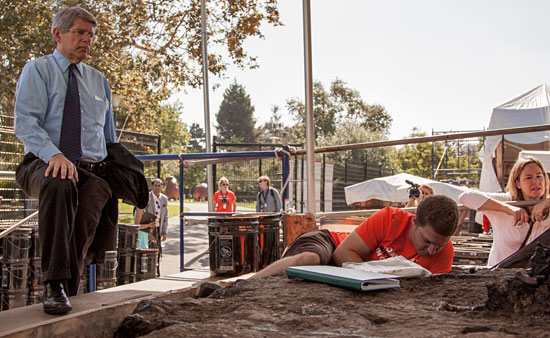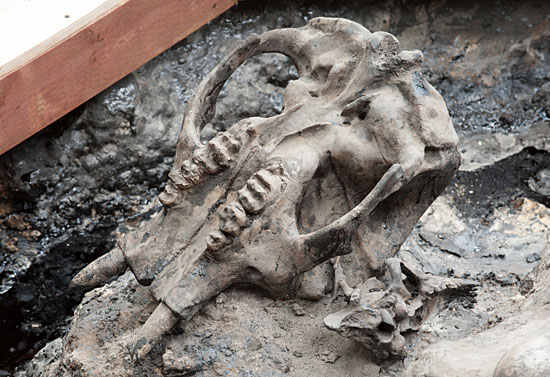Magic in the muck
June 19, 2014
John Harris loves the smell of asphalt in the morning. As chief curator of the county’s Page Museum at the La Brea Tar Pits, he’s been enjoying the pungent smell since 1980. “I open the door of the car, and I’m here,” he said, demonstrating his appreciation with a dreamy sniff.
Not everyone shares his olfactory pleasure. “It sure smells,” observed a little boy in a baggy yellow T-shirt as he checked out some of the famous black ooze before heading into the museum with his family.
Individual noses notwithstanding, there’s a sweet smell of progress around the iconic tar pits these days. The famous mammoth and mastodon statues by the bubbling lake bed have been spiffed up and, more significantly, two scientific hot spots on the museum campus have been reactivated so that the public can get a sense of the discoveries being made each day right beside busy Wilshire Boulevard.
Beginning June 28, the mid-century Observation Pit—a repository for large Ice Age fossils from throughout the tar pit area—will become a highlight of the museum’s new Excavator Tour, after being closed since the mid-1990s. At the same time, Pit 91 is now open for excavation and public viewing after a seven-year hiatus.
The re-opened sites promise to be tourist attractions, educational resources and must-see stops on any fossil geek’s itinerary. They also mean new jobs. The museum has hired two new excavators for Pit 91. In addition, two new gallery interpreters will lead tours and five new guest relations staffers have been added.
Museum officials said the Observation Pit was closed for many years to allow excavators to concentrate their attention on the very productive Pit 91, site of such key finds as the first confirmed piece of a very young mammoth. But the excavation of Pit 91 eventually ceased because of another treasure trove of fossils uncovered in 2006 during construction of the Los Angeles County Museum of Art’s subterranean parking lot. Page Museum officials decided to focus excavation resources on the new finds, the most renowned of which was a mammoth nicknamed Zed. That ongoing effort is named Project 23 after the number of crates of specimens uncovered there.
Re-opening the Observation Pit and Pit 91 seemed like a good way to give visitors a different vantage point for exploring the museum’s collection, said Jane Pisano, president and director of the Natural History Museum of Los Angeles County, which oversees the Page.
“We have a very exciting opportunity here to preserve the tar pits for present and future scientific discoveries and at the same time do a much better job for our visitors connecting the work outside with what’s on display inside the Page Museum,” Pisano said.
She added that the new exhibits offer a window into the latest scientific thinking on what fossils can teach us. The bottom line: size matters. Smaller is better for examining changes in the environment, including climate change. While it may be sexier to find a big cat or mastodon, “the reason to focus on the smaller fossils is that those critters lived here year round,” Pisano said. “We know the bison and larger animals were migrating and only came here once in a while.”
As chief curator Harris put it: “The real emphasis now is not on the big fossils, because we’ve learned pretty much what we can. Now it’s the smaller fossils and what they can tell us.”
Officials unveiled the new attractions today. Supervisor Zev Yaroslavsky said it’s all part of a virtuous cycle of education and inspiration.
“The more access that people have to the tar pits, the more their curiosity gets piqued. The more their curiosity gets piqued, the better our quality of life is. And one or two of those kids who come here may become scientists who ultimately work for the Natural History Museum, analyzing what’s found underneath these properties,” Yaroslavsky said.
The reactivated exhibits at the tar pits are part of a Miracle Mile boom that includes extending the Purple Line subway and creating a new building at the Los Angeles County Museum of Art, to be designed by renowned architect Peter Zumthor.
“This part of Los Angeles…is on a roll,” Yaroslavsky said. “We are very excited about the future as much as we are curious about the past.”

Yaroslavsky checks out some of the fossil excavation efforts taking place on the grounds of the tar pits.
Posted 6/19/14















 405 bridge work causes a stink
405 bridge work causes a stink